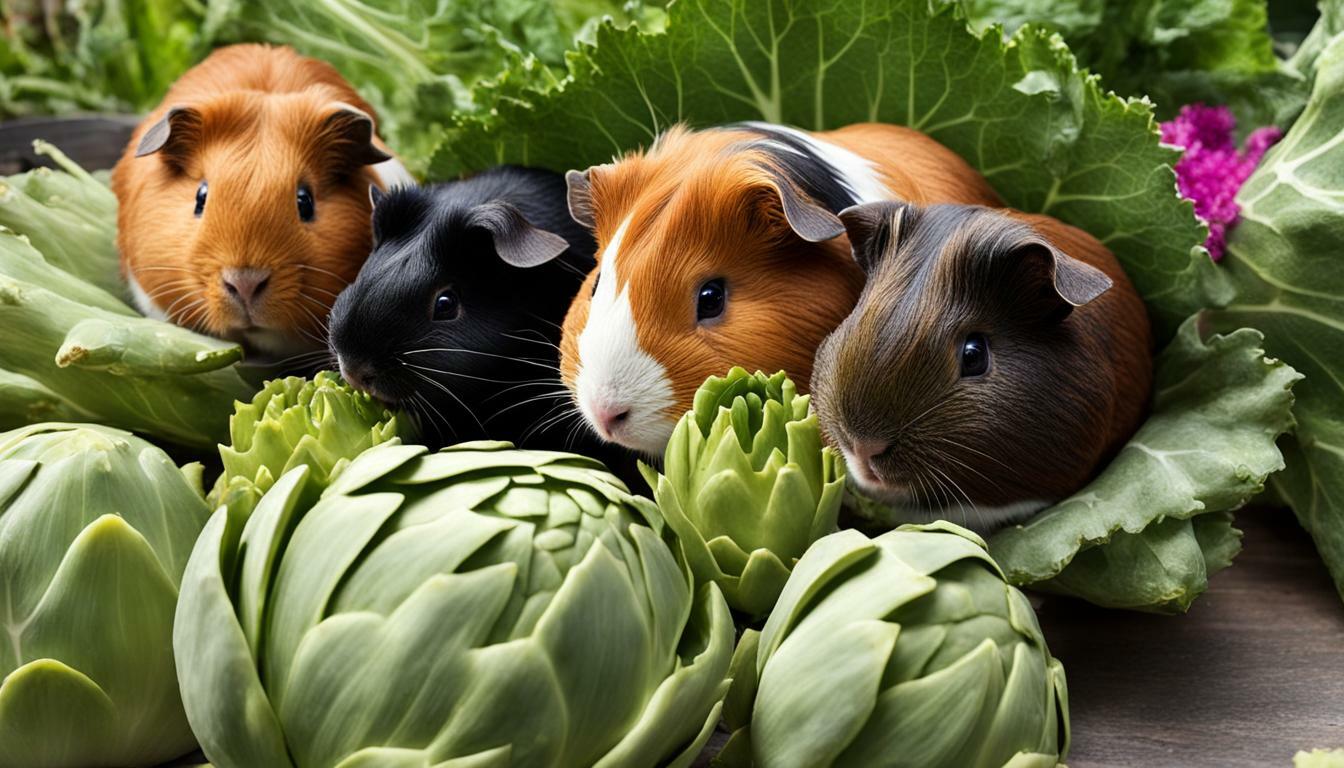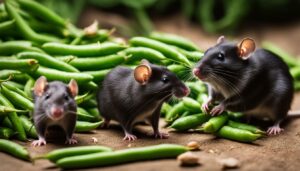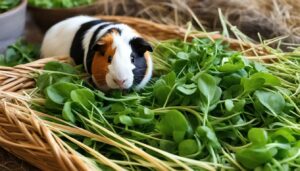If you’re wondering if guinea pigs can eat artichokes, you’ve come to the right place. Guinea pigs can indeed consume artichokes, but there are important guidelines to follow to ensure their safety and health.
Key Takeaways:
- Guinea pigs can eat artichokes, but they should be properly prepared.
- Remove the outer leaves and thorny parts before feeding artichokes to your guinea pig.
- Only feed the lighter green and white leaves of the artichoke to your pet.
- Offer artichokes to guinea pigs in small amounts, around 2-3 times a week, to prevent overfeeding.
- Artichokes are rich in essential nutrients like vitamin C, vitamin K, and fiber, which can benefit the health of guinea pigs.
Guinea Pig Diet and Artichokes
A healthy and balanced diet is crucial for guinea pigs, and artichokes can be a part of their nutritious menu.
These small, adorable pets can safely consume artichokes, but it’s important to prepare them properly before feeding.
Guinea pigs should only be given the lighter green and white leaves of the artichoke, with the outer leaves and sharp thorny parts removed.
This ensures that they can enjoy the benefits without any potential hazards.
Artichokes are packed with essential nutrients that can benefit the health of guinea pigs. They are a great source of vitamin C, which helps boost the immune system and promote overall well-being.
Artichokes also contain vitamin K, which supports bone health, and fiber, which aids in digestion. Incorporating artichokes into your guinea pig’s diet can provide them with a tasty and nutritious treat.
It’s important to feed artichokes to guinea pigs in moderation. A recommended serving size is small, around 2-3 times a week, to avoid overfeeding.
While artichokes offer numerous health benefits, it’s also crucial to be mindful of potential risks. Guinea pigs may be prone to urinary complications, digestion problems, and choking hazards, so it’s essential to be cautious when introducing artichokes into their diet.
Safe Vegetables for Guinea Pigs
Aside from artichokes, there are other safe vegetables that you can include in your guinea pig’s diet.
Leafy greens like lettuce, spinach, and kale are excellent choices, as they provide additional vitamins and minerals.
Bell peppers, carrots, and cucumbers are also safe options that can add variety to your pet’s meals.
However, remember to introduce new vegetables gradually, monitoring your guinea pig for any adverse reactions.
| Safe Vegetables | Frequency of Feeding |
|---|---|
| Artichokes | 2-3 times a week in small amounts |
| Lettuce | Daily |
| Spinach | Twice a week |
| Kale | Once a week |
| Bell peppers | Twice a week |
| Carrots | Once a week |
| Cucumbers | Twice a week |
Remember to always provide fresh vegetables to your guinea pig and remove any uneaten portions from their cage.
Maintaining a clean and hygienic environment is essential for their well-being. By following these guidelines and serving artichokes and other vegetables in moderation, you can ensure that your adorable guinea pigs have a healthy and happy diet.
The Benefits of Artichokes for Guinea Pigs
Artichokes offer more than just a delicious taste; they are packed with nutrients that can contribute to your guinea pig’s overall health.
Guinea pigs can safely consume the lighter green and white leaves of artichokes, provided they are prepared correctly.
One of the key benefits of artichokes is their high vitamin C content. Guinea pigs, like humans, cannot produce their own vitamin C and rely on dietary sources to meet their needs.
Vitamin C is essential for the proper functioning of their immune system, promoting healthy skin and hair, and aiding in the absorption of other nutrients.
Additionally, artichokes are a good source of vitamin K, which plays a crucial role in blood clotting and bone health.
Guinea pigs require vitamin K to ensure their blood can clot effectively and to maintain strong and healthy bones.
| Nutrient | Function | Food Sources |
|---|---|---|
| Vitamin C | Boosts immune system, promotes healthy skin and hair | Artichokes, bell peppers, kale, strawberries |
| Vitamin K | Aids in blood clotting, maintains bone health | Artichokes, broccoli, spinach, parsley |
| Fiber | Promotes digestion, prevents constipation | Artichokes, hay, leafy greens, carrots |
- Artichokes are also a great source of fiber, which is essential for guinea pig digestion. Fiber helps maintain a healthy gut, promotes regular bowel movements, and prevents constipation.
. - When feeding artichokes to your guinea pig, it is essential to do so in moderation. Too much of any food can lead to digestive issues, so it is recommended to offer artichokes in small amounts, around 2-3 times a week.
. - It is important to note that baby guinea pigs should not be fed artichokes, as their digestive systems are still developing. Additionally, it is best to avoid feeding them outer leaves, dried artichokes, cooked artichokes, and artichoke tea.
In conclusion, artichokes can be a nutritious addition to your guinea pig’s diet when fed in appropriate amounts.
By preparing and serving artichokes correctly, you can provide your furry friend with essential nutrients like vitamin C, vitamin K, and fiber to support their overall health and well-being.
Potential Risks and Hazards
While artichokes can be beneficial for guinea pigs, it’s important to be aware of potential risks and hazards that may arise.
It is recommended to exercise caution when feeding artichokes to your furry friends.
One potential risk is the possibility of urinary complications. Artichokes have a high calcium content, which may lead to the formation of urinary stones in guinea pigs.
It is crucial to monitor your pet’s urinary health and consult with a veterinarian if you observe any changes or symptoms.
Another risk to consider is the potential for digestion problems. Guinea pigs have sensitive digestive systems, and artichokes can be difficult for them to digest, particularly if fed in large quantities.
It’s essential to introduce artichokes gradually into their diet and observe how your guinea pig responds. If you notice any signs of gastrointestinal discomfort, such as bloating or diarrhea, it is advisable to discontinue feeding them artichokes.
Choking hazards are also a concern when it comes to feeding artichokes. Guinea pigs have small mouths and may struggle to chew and swallow the thorny parts of the vegetable.
To prevent choking, it is crucial to remove the sharp thorny parts and only offer the lighter green and white leaves of the artichoke.
| Potential Risks and Hazards: |
|---|
| Urinary complications due to high calcium content |
| Difficulty digesting artichokes, leading to gastrointestinal discomfort |
| Possible choking hazards from sharp thorny parts |
It’s important to remember that baby guinea pigs should not be fed artichokes. Their digestive systems are still developing, and introducing artichokes at an early age may cause digestive issues.
Additionally, it is advisable to avoid feeding your guinea pig the outer leaves of the artichoke, as well as dried artichokes, cooked artichokes, and artichoke tea.
These variations may be too tough or contain added ingredients that can be harmful to guinea pigs.
When preparing artichokes for your guinea pigs, it is necessary to remove the outer leaves, thorny parts, and any uneaten artichokes from their cage.
This helps maintain a clean and hygienic environment for your pets, reducing the risk of contamination or spoiled food.
In conclusion, artichokes can be a nutritious addition to your guinea pig’s diet when served in moderation and prepared properly.
However, it is vital to be aware of the potential risks and hazards they may pose. Monitoring your guinea pig’s health and consulting with a veterinarian are essential steps to ensure their well-being.
Artichokes should always be introduced gradually, and any signs of discomfort or adverse reactions should be addressed promptly.
Proper Preparation of Artichokes for Guinea Pigs
Before serving artichokes to your guinea pig, it’s essential to properly prepare them to ensure the safety and well-being of your pet.
Guinea pigs can enjoy artichokes, but it’s important to remove the outer leaves and cut off the sharp thorny parts.
You should only offer the lighter green and white leaves to your furry friend. By doing so, you can prevent any potential harm to your guinea pig’s delicate digestive system.
Artichokes should be served in small amounts, around 2-3 times a week, to avoid overfeeding. These delicious vegetables are rich in essential nutrients like vitamin C, vitamin K, and fiber, which can contribute to your guinea pig’s overall health.
However, moderation is key. Feeding your guinea pig too many artichokes may lead to digestive issues or urinary complications.
While artichokes can offer nutritional benefits, it’s crucial to be aware of potential hazards. Choking hazards can arise from the tough fibrous parts of the artichoke, so removing them before serving is crucial.
Additionally, some guinea pigs may be more prone to urinary complications when consuming artichokes. If you notice any adverse effects after feeding artichokes to your guinea pig, it is best to consult with a veterinarian.
Tips for Serving Artichokes to Guinea Pigs:
- Remove the outer leaves and thorny parts of the artichoke.
- Offer only the lighter green and white leaves to your guinea pig.
- Serve artichokes in moderation, about 2-3 times a week.
- Be mindful of potential hazards, such as choking and urinary complications.
By following these guidelines and providing artichokes in a safe and controlled manner, you can treat your guinea pig to a nutritious snack that they can enjoy while maintaining their well-being.
| Artichoke Preparations to Avoid: | Considerations for Baby Guinea Pigs: |
|---|---|
| Outer leaves | Artichokes should be introduced into the diet once they are older |
| Dried artichokes | Consult with a veterinarian before introducing artichokes into a baby guinea pig’s diet |
| Cooked artichokes | Avoid feeding artichokes to a baby guinea pig until they are fully weaned |
| Artichoke tea | Adjust the portion size and frequency based on the baby guinea pig’s age and overall development |
Feeding Artichokes to Guinea Pigs
When it comes to feeding artichokes to your guinea pig, it’s crucial to do so in a controlled manner to prevent any potential issues.
While artichokes can be a nutritious addition to their diet, it’s important to take certain precautions and follow the proper guidelines.
Start by preparing the artichokes correctly. Remove the outer leaves, as they can be tough and difficult for guinea pigs to chew.
Also, cut off the sharp thorny parts, as they can pose a risk of injury to your pet. Only give your guinea pig the lighter green and white leaves of the artichoke, as the darker leaves may be too fibrous for their digestive system.
It’s recommended to feed artichokes to guinea pigs in small amounts, around 2-3 times a week. This frequency ensures they receive the nutritional benefits of artichokes without overfeeding.
Artichokes are rich in important nutrients like vitamin C, vitamin K, and fiber, all of which contribute to their overall health.
However, it’s crucial to be aware of potential risks and hazards. Feeding guinea pigs too many artichokes or introducing them too quickly into their diet can lead to urinary complications, digestion problems, and even choking.
It’s essential to monitor your guinea pig’s response to artichokes and adjust the amount accordingly.
Remember, baby guinea pigs should not be fed artichokes, as their digestive systems are still developing.
Additionally, outer leaves, dried artichokes, cooked artichokes, and artichoke tea should be avoided, as they may contain substances that are harmful to guinea pigs.
When serving artichokes to your guinea pig, always ensure the proper preparation and removal of any uneaten portions.
This helps maintain a clean and hygienic environment for your pet. By following these guidelines, you can safely incorporate artichokes into your guinea pig’s diet and provide them with a delicious and nutritious treat.
Artichokes to Avoid and Considerations for Baby Guinea Pigs
While artichokes can be a healthy addition to the guinea pig diet, certain types and ages should be approached with caution.
Guinea pigs should only be given the lighter green and white leaves of the artichoke, as the darker, tougher leaves can be difficult for them to digest.
Additionally, baby guinea pigs should not be fed artichokes due to their delicate digestive systems and the potential for digestive upset.
Types of Artichokes to Avoid:
| Artichoke Varieties | Reason to Avoid |
|---|---|
| Purple Artichokes | The darker leaves can be tough and difficult for guinea pigs to digest. |
| Dried Artichokes | They can be too hard for guinea pigs to chew and may pose a choking hazard. |
| Cooked Artichokes | Cooked artichokes often contain added seasonings and oils that can be harmful to guinea pigs. |
| Artichoke Tea | The concentrated nature of artichoke tea can be too intense for guinea pigs’ digestive systems. |
It is important to note that each guinea pig is unique, and some may have sensitivities or allergies to certain foods.
Always monitor your guinea pig’s reaction when introducing new foods into their diet. If you notice any signs of discomfort or digestive issues, it is best to discontinue feeding them artichokes and consult with a veterinarian for further guidance.
When preparing artichokes for guinea pigs, it is crucial to remove the outer leaves and any thorny parts. Ensure that the artichokes are washed thoroughly to remove any dirt or pesticides.
After feeding, it is essential to clean the guinea pig’s cage and remove any uneaten artichokes to maintain a hygienic environment.
Overall, artichokes can be a nutritious treat for guinea pigs when fed correctly. By following the guidelines and considering the specific needs of your guinea pig, you can safely incorporate artichokes into their diet and provide them with a varied and well-balanced meal.
Cleaning and Removing Uneaten Artichokes
It is important to properly clean the guinea pig’s cage and remove any uneaten artichokes to ensure their health and well-being.
Guinea pigs are known for their sensitive digestive systems and can be susceptible to digestive issues if their environment is not kept clean.
To maintain a hygienic living space for your furry friend, follow these steps for cleaning and removing uneaten artichokes:
- Start by removing any uneaten artichokes from your guinea pig’s food dish. Discard any leftover pieces or scraps that may have become soiled or spoiled.
. - Next, carefully remove the guinea pig’s bedding, taking care not to disturb or frighten your pet. Dispose of any soiled bedding and replace it with fresh, clean bedding material.
. - Thoroughly clean the food dish and water bottle with mild dish soap and warm water. Rinse them well to remove any soap residue.
. - Using a pet-safe disinfectant, clean the entire cage, paying special attention to areas where the guinea pig may have urinated or defecated. Allow the disinfectant to sit for the recommended time before rinsing it off with water.
. - Once the cage is clean and dry, place fresh bedding, food, and water in their respective areas. Ensure that the cage is secure and free of any potential hazards before returning your guinea pig to its home.
By regularly cleaning your guinea pig’s cage and removing uneaten artichokes, you can help prevent the growth of harmful bacteria and maintain a healthy environment for your pet.
Remember to monitor your guinea pig’s eating habits and adjust their diet accordingly. If you notice any signs of illness or discomfort, consult with a veterinarian for further guidance.
With proper care and attention, your guinea pig can enjoy the benefits of artichokes as a nutritious addition to their diet.
Table: Cleaning Schedule
| Task | Frequency |
|---|---|
| Remove uneaten artichokes | Daily |
| Replace bedding | Weekly |
| Clean food dish and water bottle | Twice a week |
| Disinfect cage | Monthly |
Following a regular cleaning schedule will help keep your guinea pig’s cage fresh and hygienic, providing them with a safe and healthy living environment.
Always remember to handle your guinea pig with care and show them plenty of love and attention. Your furry friend will appreciate the clean and comfortable surroundings, allowing them to thrive and enjoy their artichoke treats!
Conclusion
Artichokes can be a nutritious and tasty addition to your guinea pig’s diet, but it is important to follow proper guidelines to ensure their safety and well-being.
Before feeding artichokes to your guinea pig, make sure to remove the outer leaves and cut off the sharp thorny parts.
Only give your pet the lighter green and white leaves of the artichoke, as they are the most suitable for consumption.
It is recommended to feed guinea pigs small amounts of artichokes, around 2-3 times a week, to avoid overfeeding.
These vegetables are rich in essential nutrients like vitamin C, vitamin K, and fiber, which can benefit the health of your furry friend.
While artichokes can be beneficial, it is crucial to serve them in moderation. Be mindful of potential risks, including urinary complications, digestion problems, and choking hazards.
It is also important to note that baby guinea pigs should not be fed artichokes.
When preparing artichokes for your guinea pig, always remove the outer leaves, thorny parts, and any uneaten portions from their cage to maintain a hygienic environment.
By following these guidelines and being attentive to your guinea pig’s needs, you can safely incorporate artichokes into their diet as a nutritious treat.
Remember, a balanced and varied diet is key to keeping your guinea pig happy and healthy!
FAQ
Can guinea pigs eat artichokes?
Yes, guinea pigs can eat artichokes, but they should be prepared properly before feeding them to your pets.
How should artichokes be prepared for guinea pigs?
The outer leaves should be removed, and the sharp thorny parts should be cut off. Guinea pigs should only be given the lighter green and white leaves of the artichoke.
How often should guinea pigs be given artichokes?
It is recommended to feed them artichokes in small amounts, around 2-3 times a week, to avoid overfeeding.
What are the benefits of artichokes for guinea pigs?
Artichokes are packed with nutrients like vitamin C, vitamin K, and fiber, which can benefit the health of guinea pigs.
Are there any risks associated with feeding artichokes to guinea pigs?
Yes, potential risks include urinary complications, digestion problems, and choking hazards.
Can baby guinea pigs eat artichokes?
No, baby guinea pigs should not be fed artichokes. They have specific dietary requirements and should not be given certain foods.
What artichokes should be avoided?
Outer leaves, dried artichokes, cooked artichokes, and artichoke tea should be avoided when feeding guinea pigs.
How should artichokes be cleaned and removed from the guinea pig’s cage?
It is necessary to remove the outer leaves, thorny parts, and uneaten artichokes from the cage to maintain a hygienic environment.




